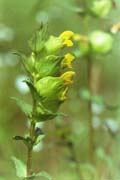34. Gentianaceae - Gentian; herbs, rarely woody; leaves opposite, entire, with stipules, often united at base; flowers perfect, usually in cymes; 4-5 sepals, free; 4-5 petals, united; stamens as many as petals, adnate to the corolla tube; carpels 2, united, with gladular disc at base.
35. Asclepiadaceae - Milkweed; sap milky; leaves opposite or shorled, stipules absent; flowers 5-merous with distinctive corona, pollinia, translators, and corpuscula; fruit a follicle, seed with a tuft of silky hairs.
36. Solanaceae - Nightshade, potato; leaves alternate, stipules absent; flowers actinomorphic, 5-merous; stamens 5; ovary 2-locular, sometimes falsely divided again; ovules numerous; fruit a berry or capsule.
37. Convolvulaceae - Morning Glory; herbs, shrubs, trees, vines, lianas; milky latex often present; leaves alternate, simple, lacking stipules; flowers perfect, bracteate, in cymes; sepals 5, separate, sometimes unequal, petals 5, united, plaited; stamens 5, adnate with the corolla, nectar disc usually present.
38. Cuscutateae - Dodder; leafless, rootless, parasitic herb; chlorophyll almost totally lacking; stems thread-like, often yellowish; flowers small, septals 4 or 5, free; petals 4 or 5, united; stamens 4 or 5, adnate to corolla.
39. Lamiaceae (Labiatae) - Mint; herbs and shrubs with square stems; aromatic; leaves opposite; inflorescences axillary or whorled; flowers 5-merous, zygomorphic; stamens 2 or 4; ovary deeply 4-lobed, style basally attached between the 4 lobes; fruit of 4 nutlets.
40. Plantaginaceae - Plantago; Herbs; leaves in a basal rosette, prominent veins are parallel; inflorescences spicate or capitate on stout or wiry scapes; flowers 4-merous; corollas membranous; stamens often exserted.
41. Oleaceae - Olive, ash; leaves opposite; flowers 4-merous, stamens 2, ovary 2-locular; seeds usually 2 per locule.

42. Scrophulariaceae - Figwort, snapdragon; flowers 5-merous, zygomorphic; corolla 2-lipped; stamens 2 or 4, sometimes with a fifth sterile stamen; ovary 2-locular, style terminal, ovules numerous.
 .
.
43. Campanulaceae - Harebell; herbs, sometimes shrubs or trees; sometimes milky latex; leaves alternate, simple, lacking stipules; flowers perfect, zygomorphic or actinomorphic, 5-merous, epigynous; sepals usually 5; petals 5, united; stamens 5, adnate to corolla, sometimes united by anthers; ovary inferior.
44. Rubiaceae - Coffee, madder; herbs, shrubs, and trees; leaves opposite or shorled, usually entire; flowers 4- or 5-merous; stamens as many as corolla lobes and alternate with them, adnate to the corolla; ovary inferior.




45. Caprifoliaceae - Honeysuckle; shrubs, sometimes lianas or herps; leaves opposite, usually simple and lacking stipules; flowers perfect, actinomorphic or zygomorphic, in cymes; sepals 5, small; petals 5, united, rotate, salverform or bilabiate; stamens usually 5, adnate to the corolla; ovary inferior.
46. Asteraceae (Compositae) - Inflorescences of involucrate heads (capitula) of 1-° florets on a common receptacle surrounded by phyllaries; pappus often present; corolla united and 5-lobed; stamens 5, forming a cylinder around the style; ovary with 2-style branches and uniloculate with a single ovule.
| TOP (Index Page) |
| Previous Subclass | Next Subclass |
| Magnoliidae | Hamamelidae | Caryophyllidae | Dilleniidae | Rosidae | Asteridae |
| Alismatidae | Arecidae | Commelinidae | Zingiberidae | Liliidae |